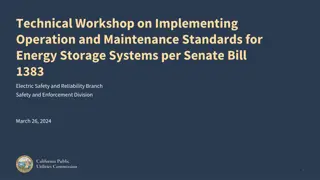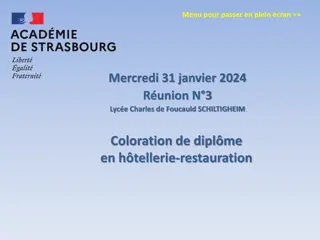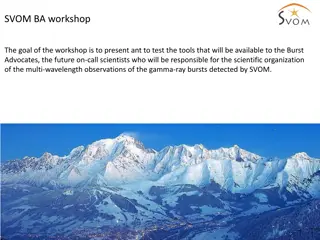Advancing Digital Preservation Through Risk Assessment and Ontology
Explore the innovative approach of utilizing risk assessment methodologies and ontology to enhance digital preservation strategies. Learn how these tools help in identifying risks, mapping mitigation measures, and aligning real-world objectives with preservation goals for effective management of digital repositories.
Download Presentation

Please find below an Image/Link to download the presentation.
The content on the website is provided AS IS for your information and personal use only. It may not be sold, licensed, or shared on other websites without obtaining consent from the author.If you encounter any issues during the download, it is possible that the publisher has removed the file from their server.
You are allowed to download the files provided on this website for personal or commercial use, subject to the condition that they are used lawfully. All files are the property of their respective owners.
The content on the website is provided AS IS for your information and personal use only. It may not be sold, licensed, or shared on other websites without obtaining consent from the author.
E N D
Presentation Transcript
Andrew McHugh Curation Pushing the Boundaries Education and Training Through Collaboration Pushing the Boundaries - - Excellence in Digital Education and Training Through Collaboration Excellence in Digital Curation Monday 1stOctober 2012
Digital Preservation Trustworthiness: How to build digital libraries/archives? How to validate digital libraries/archives? Digital Repository Audit Method Based on Risk Assessment A tool and methodology for self-assessment of repositories based on risk management Developed in DigitalPreservationEurope and Digital Curation Centre projects Built upon solid foundation of research looking into how preservation repositories function, thrive & fail
Assumption: preservation can be understood as a complex interrelationship of objectives policies rights/responsibilities Relating these can enhance understanding of risk causation and recovery objectives, policies, activities rights/responsibilities. activities, resources resources and Capacity and capability to effectively manage risk can be considered synonymous with digital preservation success
Preserved Object and Repository Risks Ontology To illustrate the relationships between factors that inform and influence the accomplishment of preservation goals: Why? To identify risks (based on common policies, infrastructure or contexts) To facilitate risk resolution (with risks mapped to appropriate mitigation measures) To perform gap analyses (with real world objectives aligned to modelled goals) To illustrate function and relate to training needs?
Initial focus on a series of repository evaluation reports undertaken in the development of DRAMBORA Parse reports, isolating information which would become ontology elements then categorising them according to a corresponding objective Developed a Semantic Mediawiki wiki to represent relationships between objectives and example institutions Generalised elements in bespoke application categorised to conform to Cornell University s three-legged stool model (organisation / technology / resources)
P..Goal P..Activity P..Parameter P..Resource P..Right / Responsibility P..Risk
Maps generic ontology to 3D content capture and management
Examples: Ensure documentation supports backwards tracing from DIPs to submitted originals Define SIP in terms of required metadata Trustworthy Repository Audit and Certification Criteria and Checklist (TRAC) PORRO reflects and greatly exceeds suggested example evidence provided by TRAC TRAC Criterion: Define ingest package specification Formalise (e.g. In Policy): Relationship between ingest, archival and dissemination packages SIP consists of content plus appropriate manifest and permission statement SIP describe in a table of contents SIP may include a title SIP may include additional archive identifiers SIP may include affiliate-assigned identifier SIP may include IDs of external metadata records SIP may include issue number SIP may include serial volume SIP must identify range of codes included in data and their meanings, in MS Word, ASCII or DDI/XML SIP must include codebook in electronic format describing contents of each variable Ensure configuration of different AIP types is documented Store metadata in corresponding AIP Determine current version of content according to time of ingest Support per-file property descriptions in file level metadata Support plain text and rich text/pictorial documentation Variable level metadata includes data definition statements Variable level metadata includes technical information (e.g. data codebooks) Study-level metadata includes high level abstracts Study-level metadata includes metadata records describing study or collection as a whole Study-level metadata includes study descriptions Minimal required metadata Package specifications Metadata creation responsibility Metadata creation workflow Seek Legitimisation From: Prescribed minimal metadata requirements Consider Threatening Risks: Extent of what is within the archival object is unclear Shortcomings in semantic or technical understandability of information Archival information cannot be traced to a received package Loss of authenticity of information Incompleteness of submitted packages Structural non-validity or malformedness of received packages Destruction of primary documentation Loss of information provenance
Validated ontology by mapping to user submissions received via DRAMBORA online interactive tool (around 400 repositories are registered as users) Similarly validated against repository evaluations and profiling activity led by US Center for Research Libraries Mapped successfully to TRAC repository criteria
Questions are welcome. Please contact me for more details (logins/questions/anything!): http://mchughontology.hatii.arts.gla.ac.uk andrew.mchugh@glasgow.ac.uk























